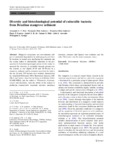Please use this identifier to cite or link to this item:
http://www.alice.cnptia.embrapa.br/alice/handle/doc/577022| Title: | Diversity and biotechnological potential of culturable bacteria from Brazilian mangrove sediment. |
| Authors: | DIAS, A. C. F.  ANDREOTE, F. D.   DINI-ANDREOTE, F.   LACAVA, P. T.   SÁ, A. L. B.   MELO, I. S. de   AZEVEDO, J. L.   ARAUJO, W. L.   |
| Affiliation: | ARMANDO C.F. DIAS, ICB-USP; FERNANDO DINI ANDREOTE, ESALQ-USP; FRANCISCO DINI-ANDREOTE, ESALQ-USP; PAULO T. LACAVA, ESALQ-USP; ANDRÉ L. B. SÁ, ICB-USP; ITAMAR SOARES DE MELO, CNPMA; JOÃO LÚCIO DE AZEVEDO, ESALQ-USP; WELINGTON L. ARAÚJO, Universidade de Mogi das Cruzes. |
| Date Issued: | 2009 |
| Citation: | World Journal of Microbiology and Biotechnology, v. 25, n. 7, p. 1305-1311, 2009. |
| Description: | Mangrove ecosystems are environments subject to substantial degradation by anthropogenic activities. Its location, in coastal area, interfacing the continents and the oceans makes it substantially important in the prospection for biotechnological applications. In this study, we assessed the diversity of culturable bacteria present over the seasons at two depths (0-10 and 30-40 cm) in a mangrove sediment and in a transect area from the land to the sea. In total, 238 bacteria were isolated, characterized by Amplified Ribosomal DNA Restriction Analysis (ARDRA) and further identified, by Fatty Acid Methyl Esther (FAME-MIDI), into the orders of Vibrionales, Actinomycetales and Bacillales. Also the ability of the isolates in producing economically important enzymes (amylases, proteases, esterases and lipases) was evaluated and the order Vibrionales was the main enzymatic source. |
| Thesagro: | Biotecnologia Mangue |
| Type of Material: | Artigo de periódico |
| Access: | openAccess |
| Appears in Collections: | Artigo em periódico indexado (CNPMA)  |
Files in This Item:
| File | Description | Size | Format | |
|---|---|---|---|---|
| 2009AP10.pdf | 198,79 kB | Adobe PDF |  View/Open |









